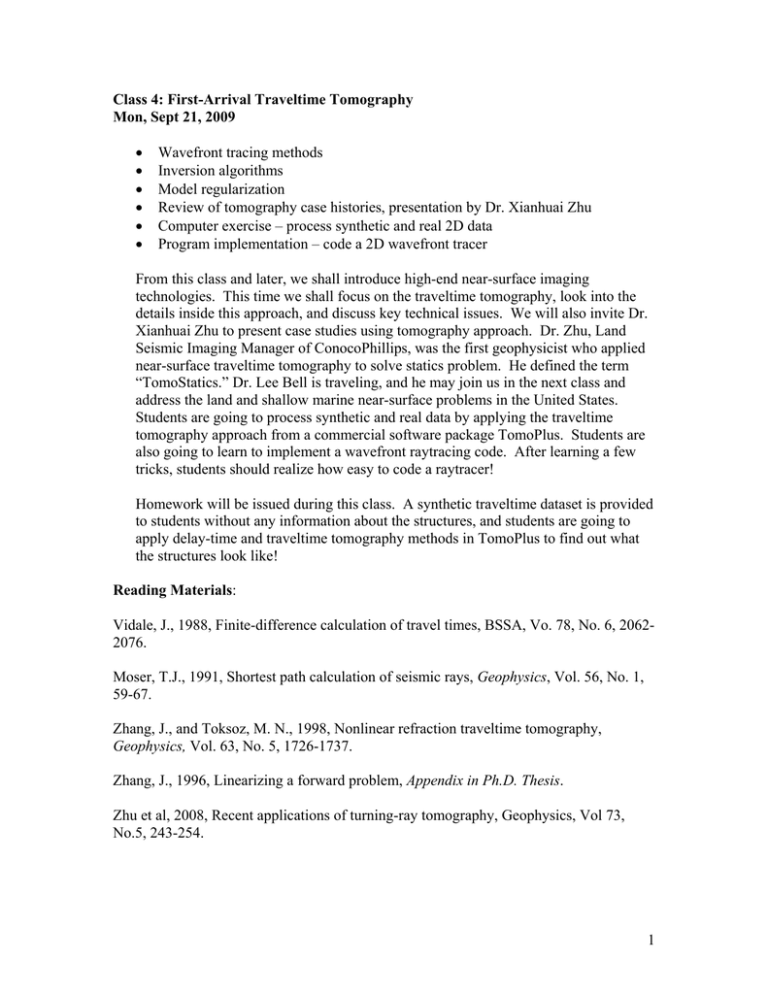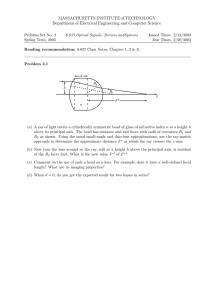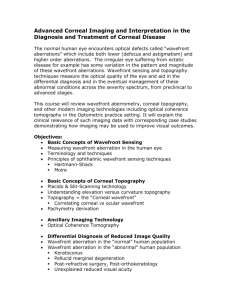Class 4: First-Arrival Traveltime Tomography Mon, Sept 21, 2009
advertisement

Class 4: First-Arrival Traveltime Tomography Mon, Sept 21, 2009 • • • • • • Wavefront tracing methods Inversion algorithms Model regularization Review of tomography case histories, presentation by Dr. Xianhuai Zhu Computer exercise – process synthetic and real 2D data Program implementation – code a 2D wavefront tracer From this class and later, we shall introduce high-end near-surface imaging technologies. This time we shall focus on the traveltime tomography, look into the details inside this approach, and discuss key technical issues. We will also invite Dr. Xianhuai Zhu to present case studies using tomography approach. Dr. Zhu, Land Seismic Imaging Manager of ConocoPhillips, was the first geophysicist who applied near-surface traveltime tomography to solve statics problem. He defined the term “TomoStatics.” Dr. Lee Bell is traveling, and he may join us in the next class and address the land and shallow marine near-surface problems in the United States. Students are going to process synthetic and real data by applying the traveltime tomography approach from a commercial software package TomoPlus. Students are also going to learn to implement a wavefront raytracing code. After learning a few tricks, students should realize how easy to code a raytracer! Homework will be issued during this class. A synthetic traveltime dataset is provided to students without any information about the structures, and students are going to apply delay-time and traveltime tomography methods in TomoPlus to find out what the structures look like! Reading Materials: Vidale, J., 1988, Finite-difference calculation of travel times, BSSA, Vo. 78, No. 6, 2062 2076. Moser, T.J., 1991, Shortest path calculation of seismic rays, Geophysics, Vol. 56, No. 1, 59-67. Zhang, J., and Toksoz, M. N., 1998, Nonlinear refraction traveltime tomography, Geophysics, Vol. 63, No. 5, 1726-1737. Zhang, J., 1996, Linearizing a forward problem, Appendix in Ph.D. Thesis. Zhu et al, 2008, Recent applications of turning-ray tomography, Geophysics, Vol 73, No.5, 243-254. 1 Traveltime Tomography Workflow: Pick First Breaks Build Initial Velocity Model Forward Wavefront Tracing or Raytracing Traveltime Inversion Update Velocity Model Final Velocity Model Forward Traveltime Calculation: Purpose: calculate theoretical traveltimes T and also calculate derivatives (raypath lij) ∂T/∂mij = lij T: traveltime between S and R; mij: cell slowness; lij: ray length in the cell i,j: cell index in 2D. Basic Theories: Snell’s law: sinθ1/sinθ2 = V1/V2 (About a ray crossing an interface) Fermat’s principle: (About a ray between two points) In Optics, Fermat's principle states that the path light takes between two points is the path that has the minimum Optical Path Length (OPL). OPL=∫c n(s)ds where n(s) is the local refractive index as a function of distance, s, along the path C. Huygens’ principle (Christiaan Huygens, 1629-1695): (About wavefront expansion starting from a point) Every point of a wavefront may be considered the source of secondary wavelets that spread out in all directions with a speed equal to the speed of propagation of the waves. Huygens’ principle Æ Fermat’s principle Æ Snell’s law 2 Raytracing: Shooting Method (Andersen and Kak, 1982) From a source point to a receiver, given an initial value, shoot rays following the equation: where ds is the differential distance along the ray, n is the refractive index (slowness), and X is the position along the ray. For undershooting or overshooting results, repeat or interpolate. Two-Point Perturbation Method (Um and Thurber, 1987) Where X′ and X′′ are the two-point positions. Xmid Xk+1 Xk-1 Xk Xk (new) Wavefront Raytracing (Wavefront Tracing) Calculate first-arrival wavefront traveltimes and associated raypaths 1) Solving the eikonal equation by finite-difference extrapolation Eikonal equation follows Fermat’s principle, Vidale’s approach also applies Huygens’ principle. 2) Graph method by following Huygens’ principle 3 Solving eikonal equation (Vidale, 1988, cited by 553) (1) Finite-difference extrapolation method Assuming source at A, to time points at B1, B2, B3, and B4: ti=(sBi + sA)h/2 (h is cell size, s is slowness) (2) h Given t0 at A, t1 at B1, t2 at B2, to calculate t3 at C1: Plane-wave approximation Circular wavefront Plane-wave approximation due to: 4 Graph method Hideki Saito and T. J. Moser presented the same approach in SEG meeting in 1989 independently. Moser’s paper was published in Geophysics in 1991 (cited 231). At ERL, Mandal (1992), Matarese (1993 ), Zhang (1996), Cheng (1997) Dijkstra Algorithm (1959): 1) Define a graph template 2) Time points near the source by the graph template 3) Find the node with minimum time, and it becomes a new source, apply the graph template to time again until every node becoming a source. 4th order graph template 5 6 HEAP Sort: Interval Approach (Klimes and Kvasnicka, 1994): interval=h/Vmax Traveltime Tree-shape raypaths: This image has been removed due to copyright restrictions. 7 This image has been removed due to copyright restrictions. Research Topics: 1) Develop a 2D super-accurate and fast wavefront raytracer by using graph method. Try 20th order graph, INTERVAL approach for sorting, mid-point corrections. 2) 3D Graph Method efficient enough? 3) Develop an algorithm to calculate raypath from 3D finite-difference traveltime volume. The approach should be stable in case that caustics occurs. 4) Develop a hybrid graph-eikonal wavefront tracer. Near the source, apply graph method, and further distance from source, apply eikonal planar wave approximation. Tomographic Inversion Method: Objective Function: ψ = ||d – G(m)||2 + τ ||L(m)||2 Where d: data; G(m): synthetics; L: Laplacian operator; τ: smoothing control; m: velocity model. 1) Gauss-Newton method: (ATA +τLTL)Δm=AT (d – G(m)) - τLTL(m) where A: sensitivity matrix, with elements ∂G(m)/∂mij = lij a) Apply Conjugate Gradient method to the above matrix problems b) Apply Greenfield algorithm to partition the matrix 2) Nonlinear Conjugate-Gradient Method: a) Compute the gradient: g0= -AT (d – G(m0)) + τLTL(m0) b) Precondition the gradient p0=Pg0, P=(ATA +τLTL)-1 ≈ (τLTL)-1 c) Initial model update: c0=-p0 d) mK+1=mK + αKcK, compute gK+1=-AT (d – G(mK)) + τLTL(mK) e) Precondition the gradient pK+1=PgK+1 f) cK+1=-pK+1 +βKcK, where βK = ((gK+1 - gK )T pK+1)/( pKTgK) 8 MIT OpenCourseWare http://ocw.mit.edu 12.571 Near-Surface Geophysical Imaging� Fall 2009 For information about citing these materials or our Terms of Use, visit: http://ocw.mit.edu/terms.






